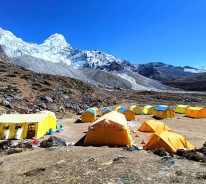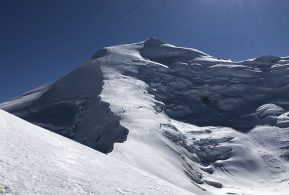Climb Ama Dablam and Lobuche Peak in a single itinerary.
Trip Overview
Highlights
- Technically challenging mountain in the Khumbu region
- Climb Ama Dablam and Lobuche East
- Fully supported expedition with the best Sherpa support
- A true Alpinist's dream
Ama Dablam Expedition 2024 Overview
| Maximum Altitude: | 6,812m/20,283ft |
| Total Duration: | 30 Days |
| Coordinates: | 27.8619° N, 86.8612° E |
| Climbing Route: | South-West Ridge |
| Grade: | Strenuous + |
| Group Size: | Min 2 Max 12 |
| Activity: | Mountaineering and Climbing |
Famously known as Mountaineer’s mountain, Ama Dablam is one of the technical mountains in the Khumbu region of the Himalayas, which stands tall at 6812m. The glacier lurking from the southwestern face gives an impression of a jewel dangling from the neck of a mountain which gave it the name of Ama Dablam (meaning Mother’s Jewel), this is a steep pyramid of ice with vertical walls and sharp, exposed ridges. Get the technical climbing experience of conquering this mountain sharply pointed. Ama Dablam summit allows panoramic views of eight-thousanders including Everest, Cho Oyu, Makalu and Lhotse.
Our Ama Dablam Expedition climbing route follows the standard route through the southwest ridge to the summit.
What makes our Ama Dablam Expedition unique?
Our Ama Dablam Expedition includes an ascent of Lobuche Peak (6119m/20,075ft) to minimise the rotation of higher camps on Ama Dablam. Trek to Everest base camp & Kalapathar, climb Lobuche East and then finally arrive at Ama Dablam base camp well acclimatized and fully prepared.
Instead of doing multiple rotations on higher camps on Ama Dablam, we will trek to Everest base camp, hike to Kalapathar and climb Lobuche East Peak before heading towards Ama Dablam. This approach/strategy has resulted in a higher success ratio on our previous Ama Dablam Expedition and we plan to follow this on our coming expeditions to Ama Dablam.
Our previous expeditions on Ama Dablam resulted in a higher success ratio for those who acclimatized on a different peak. Doing this allows the climber to be well-acclimatized, refresh their climbing skills on smaller peaks and be fully prepared when they arrive at the Amadablam base camp.
Our Ama Dablam base camp is well-appointed providing each climber with a comfortable stay. We will spend a few days at Amadablam Base Camp for rest, preparation, training and a puja ceremony.
Higher above the base camp, there are another three camps before reaching the summit. Camp 1 will be at (5,600m/18,368ft), Camp 2 will be at (5,900m/19,352ft) and Camp 3 will be at (6,300m/20,664ft).
During the summit push, we leave from base camp to camp 1, camp 1 to camp 2 and from camp 2 we leave for the summit at early dawn.
Day 01 – Climb to Camp 1 (5,600m/18,368ft) and O/N
Day 02 – Climb to Camp 2 (5,900m/19,352ft) and O/N
Day 03 – Summit push (6,812m/20,283ft) and return to Camp 2
Day 04 – Return to base camp
Please note that the above summit plan may differ during the expedition period as each climber adapts differently to an altitude.
Our Ama Dablam Expedition 2024 will consist of a small and cohesive team of climbers. We keep our group size small so that it will be efficient and effective.
Why climb Ama Dablam with us?
- Guided by some of the best guides and the Sherpa team.
- 1:1 Sherpa to climber ratio on summit day
- Quality and safety of the expedition
- Premier climbing experience on Ama Dablam
- A small and cohesive team of climbers
- A long history of high-altitude expeditions

For over 30 yrs the people who helm this venture have been successfully organizing high-altitude Expeditions ensuring safety first and service paramount. The success of the expedition depends largely on a carefully planned itinerary and the best logistics and these are what we offer. We are committed to maintaining the expedition safe and successful with the quality of service. Our emphasis is always on maintaining the small group so that it will be easy to coordinate and cooperate with each other. You will be guided by highly professional mountain guides and they are some of the best in this field.
We are dedicated to providing the highest professionalism throughout the expedition by taking utmost care of all the logistics needed for our Ama Dablam Expedition
See our 30 years of history: Here
Personalised Expedition on Ama Dablam:
We would be glad to offer a personalized expedition on Ama Dablam should you have any specific requirements or preferences.
We understand that our Ama Dablam Expedition Program may not suit everyone in terms of their preferences, requirements and also duration. If you have any personal preferences or have any requirements that you think will help you reach the summit, then please reach out to us and we can discuss and tailor an expedition, especially for you.
Important Note: Your safety is of imperative concern while traveling with Highland Expeditions. Please take care to note that your leader/guide has the authority to amend or cancel any part of the itinerary if it is deemed necessary due to your safety concerns. Every effort will be made to keep to the above itinerary; however, since this adventure entails travelling in remote mountainous regions, we cannot guarantee that we will not deviate from it. Weather or health condition of a group member, unexpected natural disasters, etc., can all contribute to changes in the itinerary. Your leader/guide will try to ensure that the trip runs according to plan, but please be prepared to be flexible if required
Trip Itinerary
Dates & Price
Our trips are available on both fixed departure and private group basis.
If you are looking for a group to join this trip please click the Fixed Departures tab for more information on departure dates, availability and price. All our fixed departures are guaranteed to run. Or, if you would like to do this trip alone, or with your friends, families & colleagues in a private group style, please fill out the contact form in Private Group tab and send us your message. We will organize a private trip for you at your preferred dates catering any request you may have.
Oct, 2024
Cost Inclusion
- 1:1 sherpa guide to climber ratio on Ama Dablam
- 1:3 sherpa guide to client ratio on Lobuche East Peak
- Peak Permit and Royalty fees for Ama Dablam and Lobuche
- All expedition organizational requirements
- Rope Fixing Fee
- All meals (B,L,D) during the trekking period
- Twin-sharing accommodation at the teahouses/lodges during the trekking period
- Personal tents at BC, kitchen tents, dining tents, shower tents, toilet tents, store tents, cooking utensils and more for your comfort.
- Freshly prepared meals at base camp by our expedition cook
- Meals and tents at higher camps during the expedition period
- 4 nights accommodation at Kathmandu Guest House with breakfast
- Satellite communication system at base camp but nominal charge for personal use
- Radio set for communication between camps
- Ktm-Lukla-Ktm internal airfare w
- Staffs wages, allowances with their insurance
- Common climbing equipment
- Porterage of climbing equipment up to base camp and back to Lukla after the expedition
- Liaison officer's daily wages and fees
- Applicable national park fees and local taxes
- 2 waterproof duffel bags
- Airport pickup and transfers
Cost Exclusion
- International airfare
- Meals in Kathmandu
- Custom for bringing any expedition goods
- Nepal entry visa fees
- Personal clothing and equipment
- Insurance (Mandatory)
- Summit bonus (USD 500)
- Tips for base camp staff (USD 200)
- Personal expenses
Essential Information
Equipment list for Ama Dablam Expedition 2024
The gear listed below is required for the Ama Dablam Expedition. We encourage you to get all equipment listed below and kindly ensure you check and try every piece of equipment. You can also buy or hire the same in Kathmandu as they are available in the many trekking shops from branded to local manufacturers in Kathmandu.
Head gears:
- Sunhat X 1
- Warm hat (should cover head & ear comfortably) X 2
- Buffs X 2
- Sunglasses/Glacier Glasses (High-quality, UV-blocking sunglasses with good all-around protection) X 1
- Ski Googles (Anti Fog and Good Ventilation)
- Headlamp with spare batteries (200-300 lumens output) X 2
Upper Body:
- Thermal or fleece base layer top X 3
- Trekking shirts / t-shirts (Breathable & quick-dry materials) X 3
- Mid weight top X 2
- Soft-shell jacket / fleece jacket X 2
- Prima-loft or light down jacket X 1
- Waterproof jacket X 1
- Hardshell Gore Tex jacket with hood X 1
- Insulated Down Jacket with hood X 1
- Expedition Down Suit X 1
Lower Body:
- Thermal or fleece base layer bottom X 3
- Trekking trousers/pants X 3
- Mid weight trousers/pants X 2
- Waterproof pant X 1
- Hardshell GoreTex pant X 1 (Non-insulated and waterproof)
- Insulated down pant X 1
Underwear:
- 5 pairs of synthetic or wool fabrics only
Foot Wear:
- Hiking Boots X 1
- Camp shoes X 1
- 8000m Mountaineering Boot X 1
- Hiking socks X 4 pairs medium to heavy (synthetic and wool)
- Liner socks X 2
- Summit socks X 2
- Flip flops X 1
Hand Wear:
- Liner Gloves X 2
- Midweight gloves X 1
- Heavy weight gloves( Leather Palm) X 1
- Down Mittens / Summit gloves X 1
Gears / Personal equipment:
- Daypack 45-55 liters (To carry water and personal items that you may require while trekking and climbing)
- Duffel bag (provided by us at request)
- Down Sleeping bag (-20 C rated) for Base Camp
- Down Sleeping bag (-30 C rated) for higher camps
- Thermarest mattress
- One liter capacity water bottle X 2 (Nalgene)
- Insulated Cover for Water bottle X 1
- Trekking poles X 1
- Camera with charger or spare batteries
- Personal snacks and energy bars
- Laundry bag to keep the dirty clothes
- Padlock
- Large plastic bags to keep the clothes dry
- Extra clothes to wear in Kathmandu
- Umbrella / Poncho
Toiletries and hygiene
- Quick drying towel
- Small face towel
- Toothbrush &Toothpaste
- Face mask
- Water treatment tools
- Soap and Shampoo (Smaller bottle)
- Face and body moisturizer
- Sun screen SPF30+ and Lip balm SPF 30+
- Hand sanitizer/Antiseptic wipes
- Hygiene products
- Basic first aid kit
Climbing Gears:
- Helmet
- Ice Axe
- Crampons
- Harness
- Carabiners (3 X Screw Gate and 3 X Snap Gate)
- Descender (ATC Guide/Figure of 8)
- Ascender/Jumar (Large Handle)
- Prussik Cord X 2
- 8mm climbing cord of 3 meters
- Avalanche transceiver (if possible)
Documents:
- Passport with validity of 6 months.
- Credit cards in case of emergencies
- Driving ID or any other ID in case of loss of your passport
- Travel Insurance (Please refer to the general information page for more detail about it)
- Flight tickets
Which boot is best for peak climbing in Nepal? https://highlandexpeditions.com/best-boots-for-nepal-peak-climbing/
Reviews

What an outstanding company. Not paying through the nose, I was a little unsure what to expect but these guys were amazing. The comfort, professionalism and safety were second to none. And their schedule was so smart, it did everything to get us to the summit. Well done guys, see you again soon

 Strenuous
Strenuous







